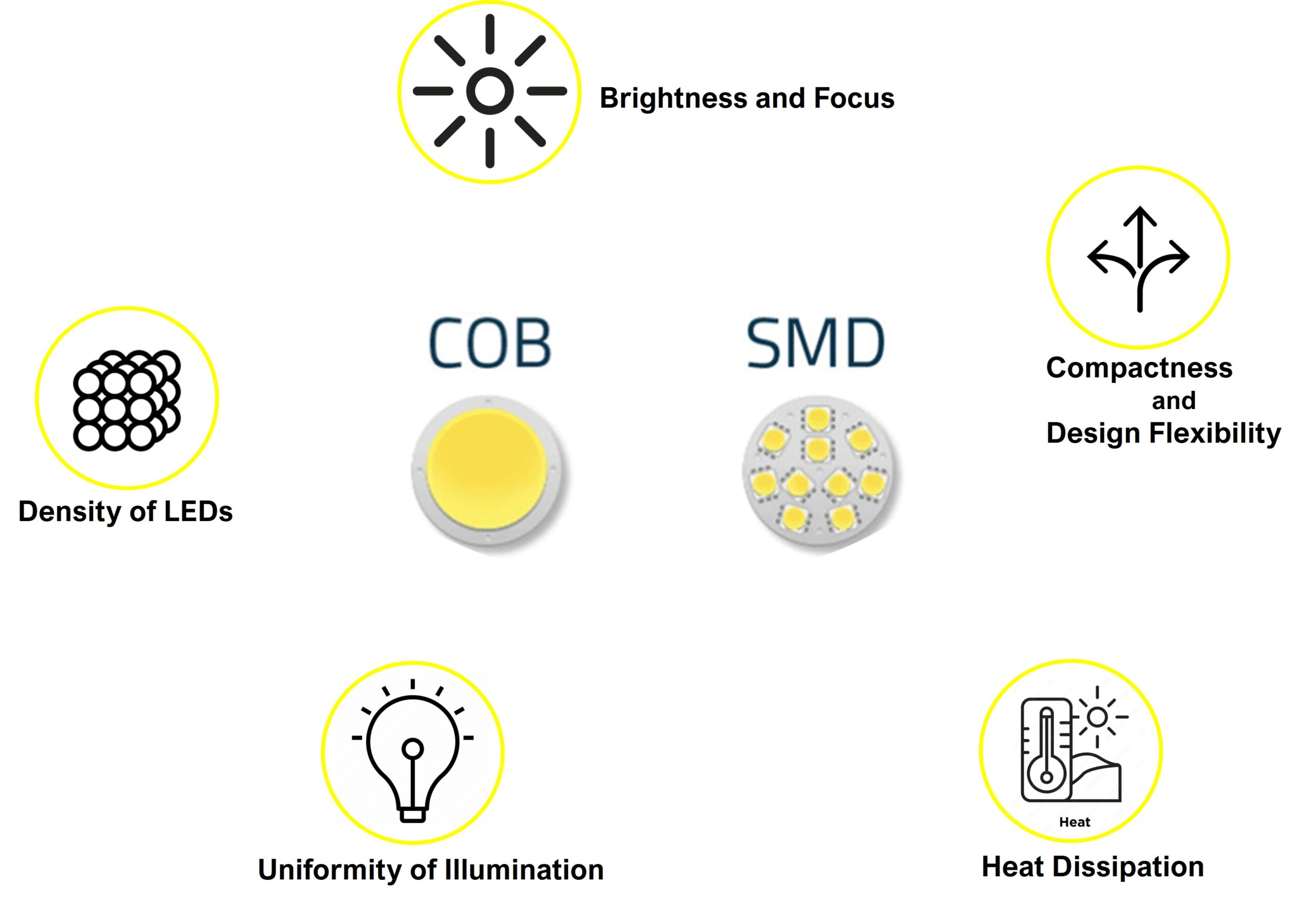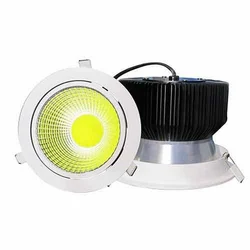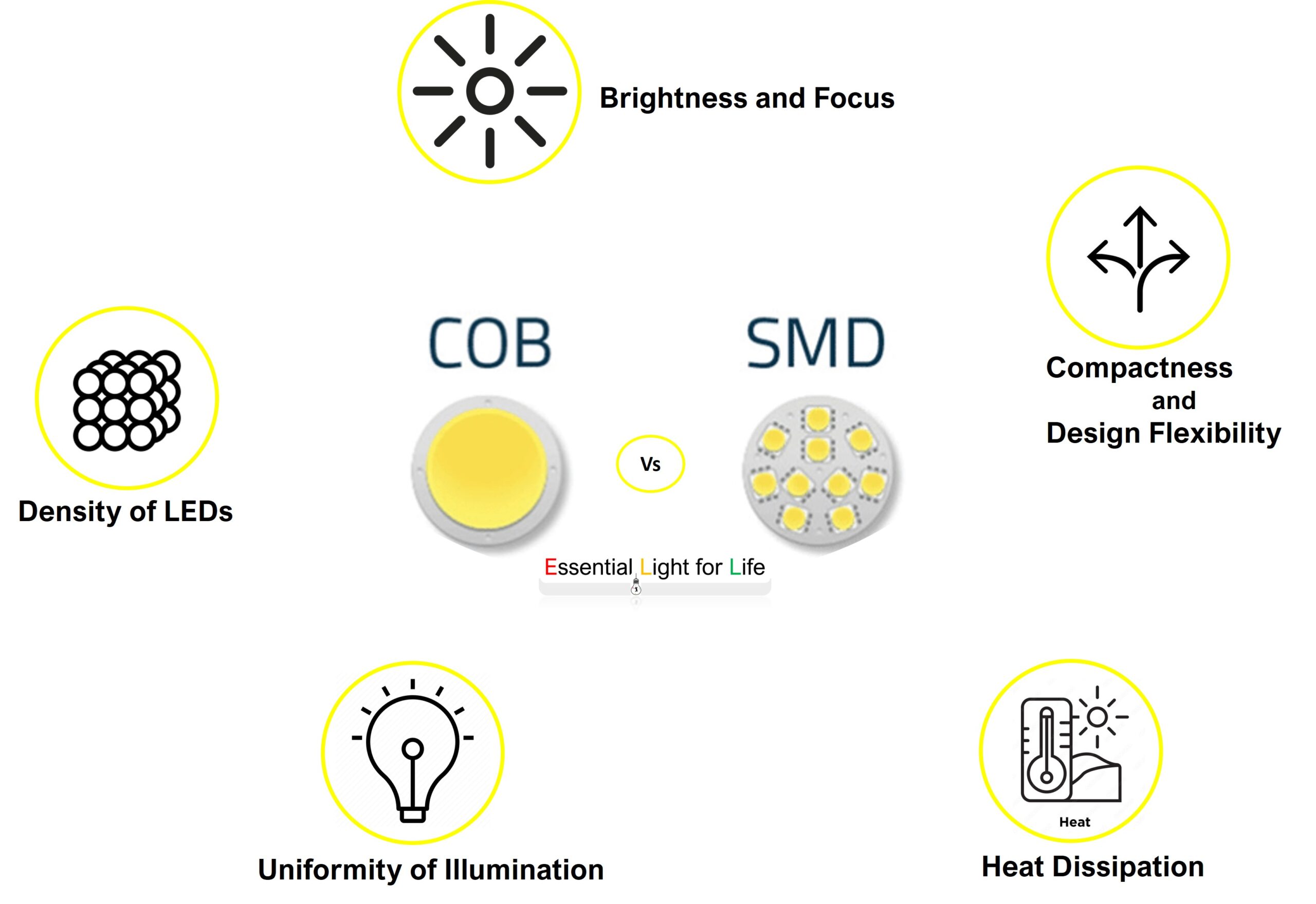In the realm of lighting technology, the competition is fierce, and consumers are presented with a myriad of options. Among these, COB (Chip on Board) LEDs have gained prominence for their powerful illumination and energy efficiency. In this guide, we embark on a comparative journey to understand how COB measures up against other prevalent LED technologies.
COB vs. SMD LEDs: Which is the Better Choice?
Brightness and Intensity:
COB LEDs, due to their densely packed chips, offer higher luminous intensity. This makes them suitable for applications where concentrated illumination is required, such as spotlights and floodlights. SMD (Surface Mounted Diode) LEDs, while efficient, may not match the intensity of COB LEDs.
Size and Form Factor:
SMD LEDs are smaller and more versatile in terms of form factor. This makes them ideal for applications that demand compact and intricately designed lighting solutions, like in displays, signage, and automotive lighting.
Heat Dissipation:
COB LEDs have an advantage when it comes to heat dissipation. The larger substrate area allows for better distribution of heat, reducing the risk of overheating. SMD LEDs, being smaller, may require additional thermal management solutions in high-powered applications.
Energy Efficiency:
Both COB and SMD LEDs are highly energy-efficient, but the edge often goes to COB due to its higher luminous efficacy. In applications where minimizing power consumption is critical, COB LEDs may be the preferred choice.
COB vs. Traditional Bulbs: Efficiency and Performance
Luminous Efficacy:
COB LEDs significantly outperform traditional incandescent and fluorescent bulbs in terms of luminous efficacy. They convert a higher percentage of electrical energy into visible light, resulting in greater energy efficiency.
Lifespan:
COB LEDs boast an impressive operational lifespan of tens of thousands of hours, far surpassing the longevity of incandescent and fluorescent bulbs. This reduced replacement frequency not only saves on maintenance costs but also contributes to sustainability efforts.
Color Rendering Index (CRI):
COB LEDs often have a higher CRI compared to traditional bulbs. This means they render colors more accurately and vividly, which is crucial in applications like retail lighting and photography.
Environmental Impact:
COB LEDs are environmentally friendly as they contain no hazardous materials like mercury (found in fluorescent bulbs) and emit lower levels of carbon dioxide. This reduces their carbon footprint and makes them a greener choice.
Conclusion:
While each lighting technology has its strengths and applications, COB LEDs shine brightly in terms of efficiency, intensity, and longevity. Whether compared to SMD LEDs for focused applications or traditional bulbs for overall efficiency, COB LEDs emerge as a formidable choice. As the lighting landscape evolves, COB technology stands at the forefront, illuminating the path toward a more energy-efficient and brilliantly lit future.
Frequently Asked Questions
What is COB LED technology?
COB stands for Chip on Board. It refers to the packaging of multiple LED chips closely together on a single board. This results in a high-intensity, concentrated light source.
How does COB LED technology differ from SMD?
SMD (Surface Mounted Diode) LEDs are individual diodes mounted on a surface, while COB LEDs involve multiple LED chips placed directly on a circuit board. COB LEDs offer higher intensity and are often used for applications requiring focused, intense lighting.
Which is better SMD strip or COB strip?
The choice between SMD (Surface Mounted Diode) and COB (Chip on Board) LED strips depends on the specific application.
- SMD Strip: SMD LED strips are composed of multiple individual LEDs mounted on a flexible circuit board. They are known for their versatility and are suitable for a wide range of applications. They provide uniform lighting and are available in various color temperatures and brightness levels.
- COB Strip: COB LED strips feature multiple LED chips tightly packed together on a single board. They offer high intensity and are excellent for applications where a high lumen output is required. COB strips can provide more focused and intense lighting compared to SMD strips.
Which is brighter, SMD or LED?
This question seems to be comparing two similar things. SMD (Surface Mounted Diode) LEDs are a type of LED. If you’re asking about the brightness between SMD and COB LEDs, COB LEDs are generally considered to be brighter due to their higher lumen output and concentrated light source.
What is the difference between SMD and COB temperature?
It appears there may be a slight misunderstanding in the question. SMD and COB refer to different types of LED technologies, not temperature. Both types of LEDs can come in various color temperatures (e.g., warm white, cool white, etc.), which is a measure of the visual warmth or coolness of the light.
What are the disadvantages of SMD LED?
While SMD LEDs are widely used and versatile, they do have some potential disadvantages:
- Heat Dissipation: SMD LEDs can generate heat, and without proper heat sinking or ventilation, this can reduce their lifespan.
- Shadowing Effect: Due to the arrangement of individual diodes, SMD LEDs may produce slight shadowing effects, especially in applications where uniformity is critical.
- Lower Lumen Density: Compared to COB LEDs, SMD LEDs may have a lower lumen density, which means they may not be as suitable for applications where high intensity is required.
What is the lifespan of SMD LED?
The lifespan of an SMD LED can vary based on factors such as the quality of the LED, operating conditions (like temperature), and drive current. On average, high-quality SMD LEDs can last between 25,000 to 50,000 hours or more. It’s important to note that “lifespan” refers to the point at which the LED’s brightness has depreciated to around 70% of its initial output.
Remember, specific performance can vary based on the manufacturer and design, so it’s always a good idea to check the specifications provided by the manufacturer.
Certainly! Here are some frequently asked questions about COB (Chip on Board) vs. Other LED Technologies:
What are the advantages of COB LEDs over traditional LEDs?
COB LEDs have advantages such as higher lumen output, better color rendering, and increased efficiency. They also provide more focused and intense lighting compared to traditional LEDs.
Are COB LEDs more energy-efficient than other LED types?
COB LEDs are generally more energy-efficient than traditional LEDs. Their concentrated design allows for higher light output with fewer components, which can lead to increased energy efficiency.
In what applications are COB LEDs commonly used?
COB LEDs are often used in applications where high intensity and focused lighting are crucial. They are commonly found in spotlights, downlights, automotive headlights, and industrial lighting.
What are the potential disadvantages of COB LEDs?
COB LEDs can generate more heat due to their high lumen output, which may require additional heat management solutions. They can also be more expensive upfront compared to some other LED types.
How does COB LED technology compare to filament bulbs?
COB LEDs are more energy-efficient and longer-lasting than traditional filament bulbs. They also offer better color rendering.




